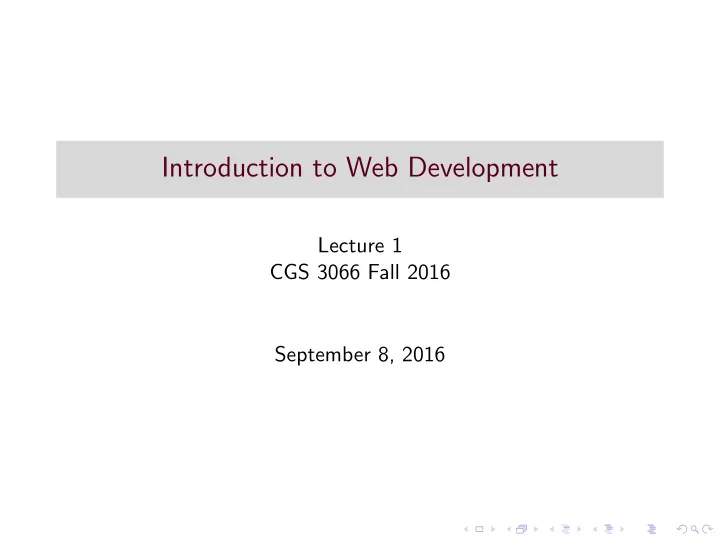

Introduction to Web Development Lecture 1 CGS 3066 Fall 2016 September 8, 2016
Why learn Web Development?
Why learn Web Development? ◮ Reach Today, we have around 12.5 billion web enabled devices. ◮ Visual Medium It’s easier to market your product if people can “see” it. ◮ The Social Nature of the web. ◮ It’s fun. ;) ◮ It pays very well. $$ ◮ You can market your own idea (as opposed to having a “technical co-founder” for your start-up). ◮ It’s important to do it well.
How it works
What we’ll learn in this course ◮ HTML 5 - The current standard for the language that describes the contents of the webpage. ◮ CSS - Used to add styles to a plain HTML document. ◮ JavaScript - Makes the website dynamic. Responds to user. ◮ PHP - Scripting language used on the server side. Used to connect the website to other utilities. ◮ We’ll be looking at several JavaScript frameworks including jQuery, Angularjs and React.js. ◮ As we progress through the course, elements of basic software engineering, content management, responsive design and Material Design will be introduced.
HTML ◮ HTML is a markup language. It tells the web browser what content to display. ◮ Separates content from presentation. ◮ Uses a pre-defined set of elements to identify content types. ◮ Elements contain one or more “tags”. ◮ Tags are surrounded by angle brackets, and the “closing” tag is prefixed by a forward slash.
HTML Page Structre
HTML Tree Structure
DOCTYPE ◮ The DOCTYPE is typically the first line of the HTML document. ◮ It specifies the version of HTML used on the page. ◮ HTML5 has a very simple DOCTYPE element. < !DOCTYPE html > ◮ HTML4 DOCTYPE element - < !DOCTYPE html PUBLIC “-//W3C//DTD HTML 4.01 Transitional//EN” >
Basics of HTML 5 ◮ Every HTML document (web page) consists of tags and character data. ◮ Tags are elements enclosed in angle brackets. ◮ < html > , < body > , < a > , < /a > , < /body > , < /html > ◮ Opening and ending tags must be used together. ◮ Character data is the content between an opening and closing tag. < title > Hello World < /title >
HTML Elements ◮ An element is a combination of a tag and its character data. ◮ < title > Hello World < /title > ◮ < body >< p > Welcome to the world < /p >< /body > ◮ < a href=“www.google.com” > Google < /a > ◮ < br/ > ◮ It is possible to nest elements inside other elements. ◮ It is possible to have empty element (no content/character data). ◮ HTML tags are not case sensitive. ◮ By convention, tags are written in lowercase.
Attributes ◮ Attributes provide information about HTML elements. ◮ An element can have one or more attributes. ◮ id ◮ class ◮ style ◮ href ◮ Attributes come in name/value pairs. < a href=“www.google.com” > Go to Googles website < /a > ◮ Some attributes can be used on any HTML element: ◮ class: specifies one or more classnames for an element (refers to a class in a style sheet). ◮ id: specifies a unique id for an element. ◮ style: specifies an inline CSS style for an element. ◮ title: specifies extra information about an element.
HTML Comments ◮ Comments can be added into the HTML code to make it readable and understandable. ◮ Browsers will not display any comments. ◮ Syntax: < !– – > E.g., < !– This is my comment – >
Cascading Style Sheets ◮ CSS stands for Cascading Style Sheets. ◮ Current Version: CSS 3. ◮ Styles define how to display HTML elements. ◮ Styles were added to HTML 4.0 to solve a problem. ◮ The original purpose of HTML was to combine the structure and content of the page into one document. ◮ When presentation elements began to be included in the document, it increased the complexity and reduced readability.
The Solution
Why CSS? ◮ Separate the “style” elements from the documents and put it in a “style sheet”. ◮ Advantages: ◮ Styles can be changed easily. ◮ Document is more readable. ◮ 3 ways to do styling ◮ Inline Style - Style elements are included as HTML attributes. ◮ Internal Style Sheets - A < style > tag is used in the HTML document to specify the presentation elements. External Style Sheets - A separate “.css” file is used as a part of your set of documents. It contains all the styling elements.
Recommend
More recommend